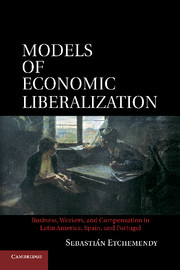 Models of Economic Liberalization
Models of Economic Liberalization Book contents
- Frontmatter
- Contents
- Acknowledgments
- Part I The Intellectual Terrain
- Part II The Political Economy of Business Adjustment
- Part III The Political Economy of Labor Adjustment
- Part IV The Market Model
- 8 Compensating Outsiders
- Part V Comparative Perspectives in Ibero-America
- 10 Conclusions
- Appendix
- Bibliography
- Index
8 - Compensating Outsiders
Chile’s Market Model in the Comparative Framework
from Part IV - The Market Model
Published online by Cambridge University Press: 07 October 2011
- Frontmatter
- Contents
- Acknowledgments
- Part I The Intellectual Terrain
- Part II The Political Economy of Business Adjustment
- Part III The Political Economy of Labor Adjustment
- Part IV The Market Model
- 8 Compensating Outsiders
- Part V Comparative Perspectives in Ibero-America
- 10 Conclusions
- Appendix
- Bibliography
- Index
Summary
Introduction
This chapter analyzes the Market path to economic liberalization, which in this book is embodied by Chile under Pinochet (1973–89) and Fujimori’s Peru (1990–2000). The essential features of the Market model are unilateral imposition and marginalization of ISI insiders, that is, protected industrial business and labor actors, and an explicit national strategy to compensate, and eventually politically mobilize, the atomized poor in the informal sector, or ISI outsiders. The “Market” label indicates that the state did not develop any major form of political payoff (neither a system of subsidies nor market-share compensation) aimed at mitigating the cost of adjustment for industrial firms, and their workers or unions, in the way that it did in the Statist or Corporatist models. Sectoral readjustments in industry were largely left to the market. In both Chile and Peru the financial sector, international investors, and multilateral institutions were clearly prevalent in the initial liberalizing coalition. While unions and other independent popular actors were sidelined, the neoliberal elite attempted to gain legitimacy and support for new pro-market parties through the compensatory policies targeted at the informal poor or outsiders.
In Chile, the critical stage of “Market” adjustment took place between 1975 and 1982 when the economic team led by the “Chicago Boys” implemented a bold stabilization plan and sweeping financial, commercial, and structural reforms. Although after the 1982 debt crisis a more pragmatic approach to economic policy prevailed, Market restructuring had already taken a considerable toll: state downsizing, currency overvaluation, and radical tariff liberalization had provoked massive bankruptcies in industry and a peak of 30% unemployment. The chapter argues that the Market path to industrial and labor adjustment in Chile had its main sources in the authoritarianism of the regime, and in the weak nature of the ISI actors that unfolded prior to reform – especially business but also labor.
- Type
- Chapter
- Information
- Models of Economic LiberalizationBusiness, Workers, and Compensation in Latin America, Spain, and Portugal, pp. 221 - 254Publisher: Cambridge University PressPrint publication year: 2011


